This is part of a series of articles on activation and making sure users experience and appreciate your product’s value.
It’s critical for products to deliver value to users as quickly as possible. That’s why one of the key metrics for user activation is time to value. In this article we will be discussing the importance of time to value, how to measure it, and how to use it to improve activation rates.
→ Test your product management and data skills with this free Growth Skills Assessment Test.
→ Learn data-driven product management in Simulator by GoPractice.
→ Learn growth and realize the maximum potential of your product in Product Growth Simulator.
→ Learn to apply generative AI to create products and automate processes in Generative AI for Product Managers – Mini Simulator.
→ Learn AI/ML through practice by completing four projects around the most common AI problems in AI/ML Simulator for Product Managers.
All posts from the series
01. When user activation matters and you should focus on it.
02. User activation is one of the key levers for product growth.
03. The dos and don’ts of measuring activation.
04. How “aha moment” and the path to it change depending on the use case.
05. How to find “aha moment”: a qualitative plus quantitative approach.
06. How to determine the conditions necessary for the “aha moment”.
07. Time to value: an important lever for user activation growth.
08. How time to value and product complexity shape user activation.
09. Product-level building blocks for designing activation.
10. When and why to add people to the user activation process.
11. Session analysis: an important tool for designing activation.
12. CJM: from first encounter to the “aha moment”.
13. Designing activation in reverse: value first, acquisition channels last.
14. User activation starts long before sign-up.
15. Value windows: finding when users are ready to benefit from your product.
16. Why objective vs. perceived product value matters for activation.
17. Testing user activation fit for diverse use cases.
18. When to invest in optimizing user onboarding and activation.
19. Optimize user activation by reducing friction and strengthening motivation.
20. Reducing friction, strengthening user motivation: onboarding scenarios and solutions.
21. How to improve user activation by obtaining and leveraging additional user data.
What time to value is
Time to value measures how long it will take for a user to personally experience a product’s added value. In other words, the amount of time from sign-up to the “aha moment”.
When thinking about how to design the onboarding experience and first user session with the product, we should always try to reduce the time to value.
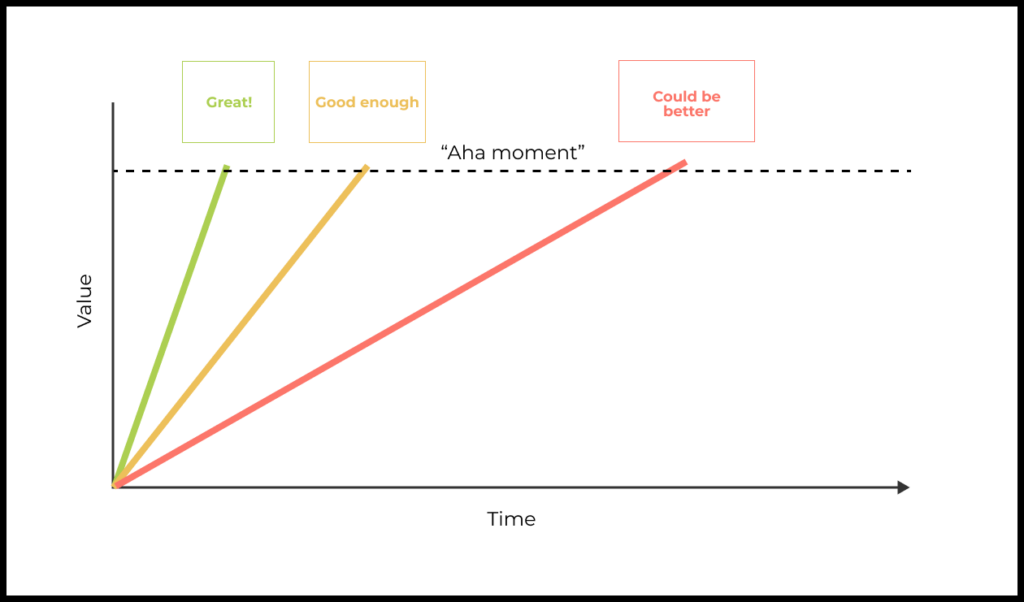
Why it’s important to minimize time to value
You invest in marketing in order to find target users and convince them that your product can make their life better. These users have a certain amount of motivation and energy that they are willing to devote to figuring out whether your promises match the reality of your product.
Every minute that user spends in your product, and every action they take, consumes some of this energy. Have they run into a complication? Are they confused by something in the product? These all cumulatively sap the user’s motivation to master a product that is new to them. If the user runs out of energy before they’ve experienced the product’s added value and seen how the product can make their life better, they are very likely to abandon it forever.
Reducing the time to value enables guiding a larger percentage of users to the “aha moment”. By doing this you can activate more new users, with the potential to take product growth to a whole new level.

You’ve probably had the experience of starting a book or a TV show only to soon get bored and give up on it. But later, perhaps because of a friend’s recommendation, you came back to it and got hooked. The show did have value after all, it’s just that the first episodes failed to convey it to you. Your patience had run out and you decided you had better things to do.
The faster that a TV show, book, game, or any other product can get users hooked by enabling them to experience value, the more likely these new users will stay for the long haul.
Why the metric for the “aha moment” is time-limited
When we measure the “aha moment”, it’s important that we put a time limit on how long the user has to perform an action. Remember when we were determining the “aha moment” for Workplace from Meta. Our metric was for a new user to view N posts within 7 days of signing up. This was the “deadline” for the user to experience added value (this example is an imaginary one, of course).
We set this time limit because the time to value is so important. If a user does not experience added value within the given timeframe, then the chances of that user later activating and converting to a regular user are virtually zero.

How to measure time to value for your product
Here we’ll detail two approaches for measuring time to value.
With the first approach, we measure time to value based on empirical user data from the product. In the second one, we carefully estimate the time to value and compare different journeys for user activation.
Each approach has pros and cons that make it more appropriate for certain situations.
Measuring time to value based on user data
The first way to measure time to value relies on data about user behavior.
We measure the time to value by taking the users who have signed up for the product and experienced the “aha moment”. For these users, we then calculate the average (median) time between these two events.
The main advantage of this time to value calculation method is that it returns a number. We can even segment the resulting metric for different traffic sources, user “jobs”, and product versions as well as observe changes over time.
The main weakness of this method is that it includes only the subset of users who reached the “aha moment”, not the entire population of users who have tried the product. The resulting survivor bias can complicate analysis of the data.
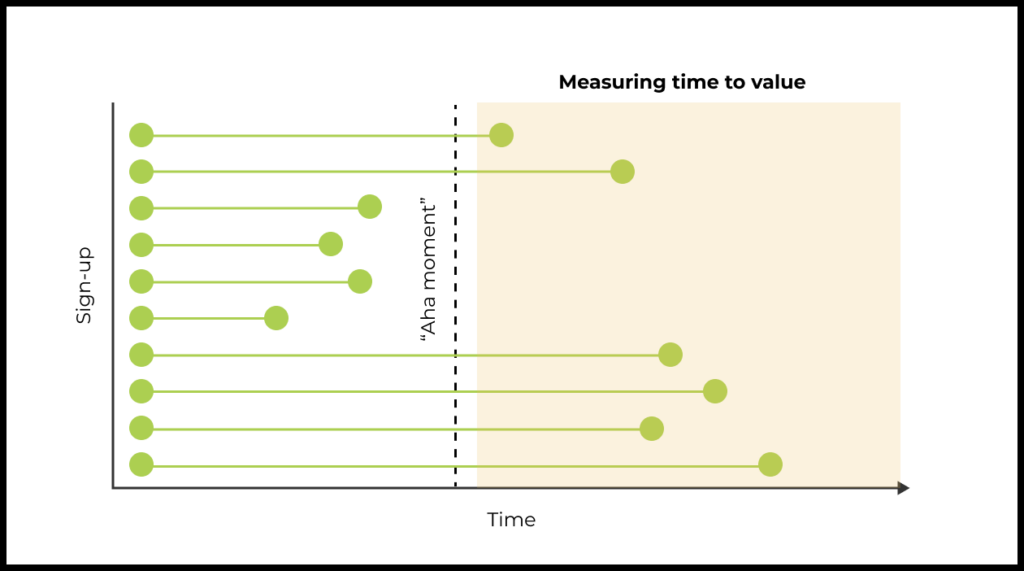
Here is one such statistical curveball: notifications have been added in a new version of the product, increasing the percentage of users reaching the “aha moment”. Although this change improves the activation rate, these new users experience the “aha moment” later than the other users did previously. The average time to value rises as a result. So whenever we use this method to calculate time to value, be sure to keep an eye on the percentage of users reaching the “aha moment”.
The specific measurement method will depend on the analytics system that you use. In Amplitude, for example, you can look at users from sign-up to target action and select the Time to Convert report. You get a report with distribution of users based on how much time elapsed before they performed the action in question.
Below is a sample report for the game Epic Split, whose development we have described previously:
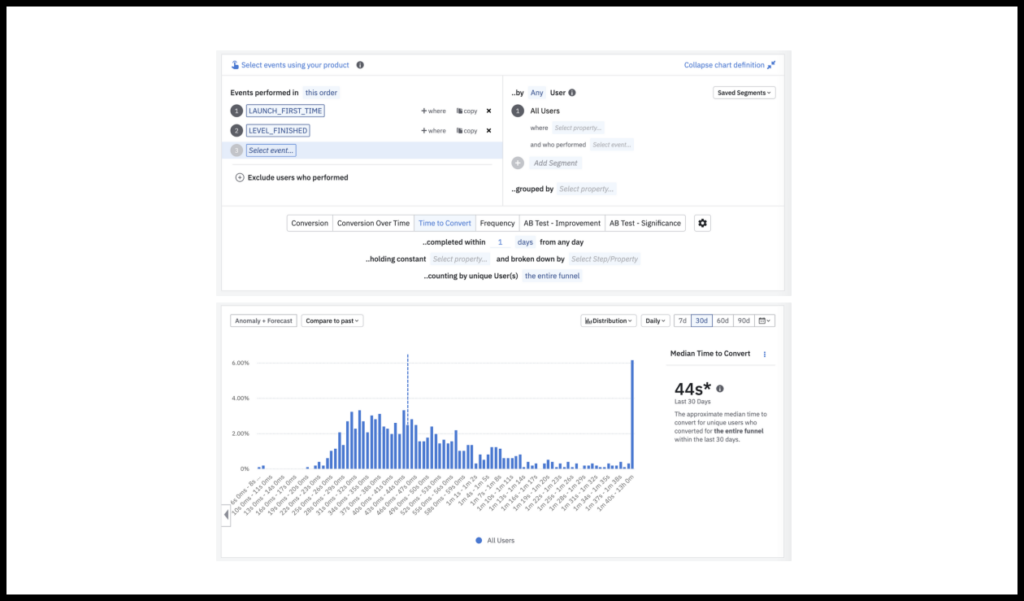
Amplitude can also plot the time to value on a chart, showing time to convert for users who joined on a given date:
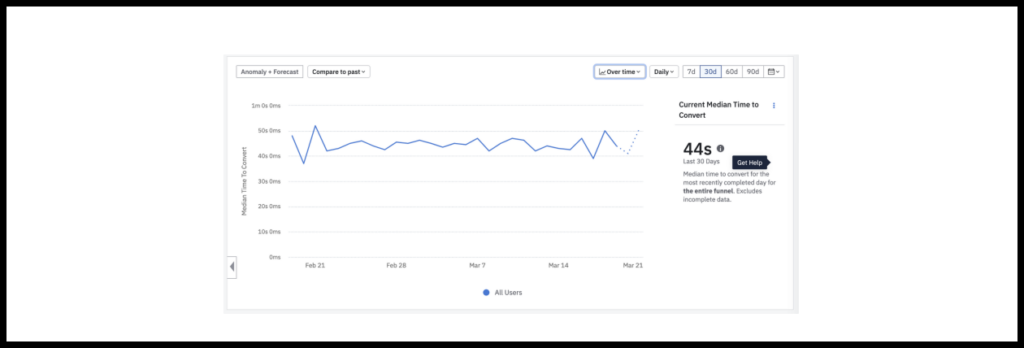
Measuring time to value for different user journeys
The other way to measure time to value is based on carefully comparing the different journeys for users on a customer journey map (CJM).
The difference is that in this case, we are not trying to find a precise number to describe the time to value. The goal is to compare each of the activation journeys and determine which one leads the user to the expected result with the most speed and least effort.
For this we use either qualitative research or the judgment of a UX expert based on a storyboard and the steps necessary for a user to reach the “aha moment”.
This method is a good option at the design stage or when testing big changes to activation mechanisms. It tells us about effects in how and when value is surfaced to the user.
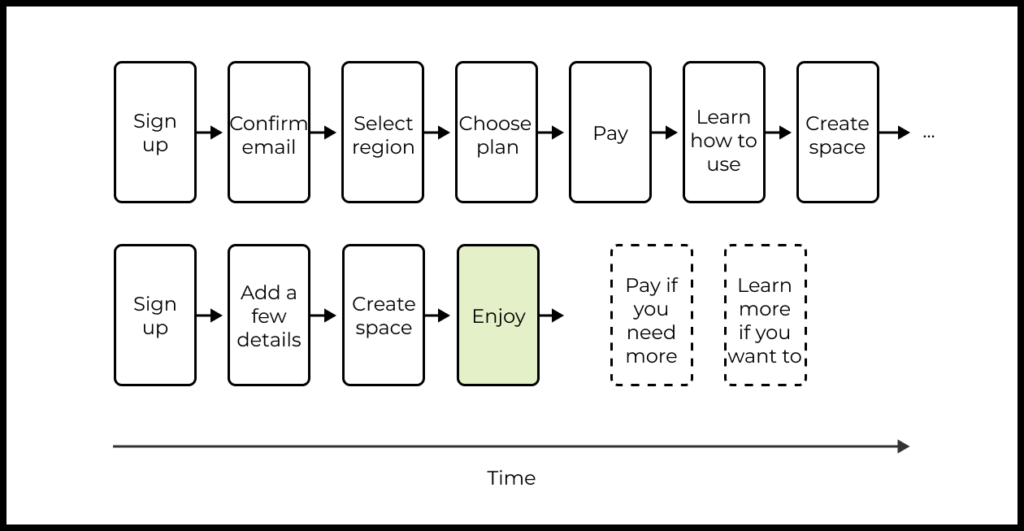
Real-world examples of reducing time to value
BlackBerry
The first BlackBerry devices went on sale in 1999. Their added value was the ability to access email whenever and wherever convenient: between meetings, in the taxi, waiting for a plane, or during downtime at an event.
But the team ran into a problem. It was hard to convince potential clients of the product’s value just by telling them about it. For clients to truly understand this value, they had to pick up a device and start using it themselves. When they got the device in their hands, they usually became believers. Clients were particularly impressed when the latest BlackBerry versions could often receive new emails more quickly than desktop PCs.
The catch was, how could people try out this expensive device before buying it? Before a user could experience value personally, they had to shell out a large amount of money.
This barrier inspired the team to overhaul the company’s sales approach. They started letting clients try out devices in the field, with the ability to return the device if it didn’t meet expectations. They neutralized the price barrier that had previously prevented new users from experiencing the added value of a BlackBerry and substantially boosted sales.
Bookmakers
The added value of bookmakers is that it’s much more exciting to watch sports when you’ve bet money on the outcome.
Traditionally, the journey to getting that value was long and complicated. A user would have to first create an account, attach a credit card, fund their account, pick a sports event, and place a bet.
But online “bookies” have rethought the onboarding process. Every new user now receives a small amount to place their first bet. Curious first-time users don’t need to enter their credit card number, fund their account, or even take the risk of losing money. This dramatically reduces the time to value and enables a larger percentage of new users to reach the “aha moment”.
Main methods for reducing time to value
Reducing time to value with user acquisition
If non-target users come to your product at the wrong time, then even a perfect activation flow won’t articulate value or convert those users into regular ones.
The job of marketing is to set expectations and encourage users to sign up when and only when they have sufficient motivation to perform the actions necessary for experiencing the product’s value.
Think about the context and level of preparation necessary to start reading a beach novel versus an intricate philosophical work. They are very different! So when attracting clients, make sure to account for this.
Time to value can also be improved at the sales funnel level, by surfacing value to users without requiring any action on their part. For example, advertising networks have made online banners where users can try out gameplay without even leaving the current page.
Companies can deliver value to users upfront before they have even signed up. AWW App provided users with an online whiteboard on the main page of their site, no sign-up required. This enabled AWW App to edge out the market leader, Miro, in organic search. From Google’s point of view, AWW App had substantially better metrics than the competition because the average user dwell time after clicking the link in search results was 15 minutes.
One more way to reduce time to value is to create free sub-products that either integrate into the start of the user journey or help to accomplish product/channel fit.
The classic example of this is content marketing, where an informative post simultaneously generates value and draws the client into the sales channel.
Reducing time to value with thoughtful design and activation
Teams often try to solve activation issues with optimizations and incremental improvements, even when the actual problem is deeper and caused by broken design. In these cases we should concentrate not on tinkering around the edges, but on rethinking activation entirely.
We already know that activation mechanisms will vary for each use case. We’ve learned how to spot the pivotal actions that are at the heart of the onboarding process: the “aha moment” and the conditions necessary for it. We also know that the product’s value needs to be delivered in small portions and in the right order.
In future materials we will continue discussing how to fit activation around these pivotal actions in order to minimize time to value. Among other topics, we will explain why it’s important to lay the groundwork for activation by working backwards from value to sign-up.
Reducing time to value with optimization of key product funnels
Once you have an overall structure for onboarding and activation, it’s time to flesh it out and optimize it.
Your main tools at this stage will be to work on UI texts, refine the interface, integrate with third-party services to minimize the data and actions required from users, support notifications, and put Customer Success Managers on the job.
Your goal is to remove absolutely anything blocking the user’s journey to value, minimize the amount of work needed at each step, and make that value resonate with the user. All of this accelerates the value journey and improves the time to value.
Time to value: an important metric for improving activation
Time to value is critical to improving product activation rates. Minimizing time to value enables delivering a product’s added value to the majority of new target users, which improves activation and bends the growth curve upwards.
There are two options for measuring time to value: calculate from actual user data or analyze user journeys based on a customer journey map. When to use each of these methods will depend on the context, based on their advantages and disadvantages.
The primary levers for improving time to value include user targeting and frontloading of value, onboarding and activation flows, and optimization of key funnels within the product.






